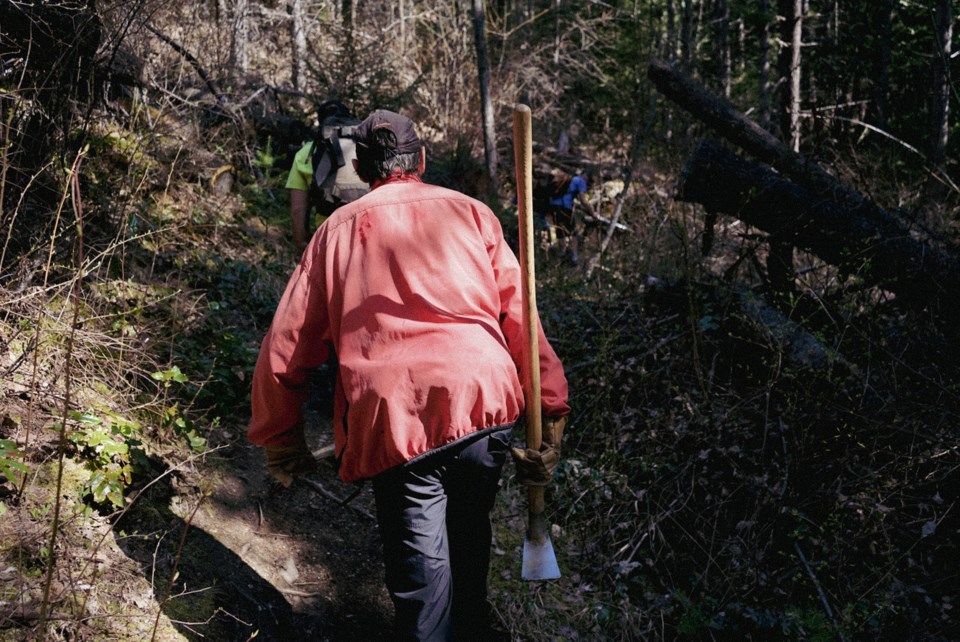Tourists come from all over the world to run and ride on Pemberton's extensive network of trails. Now, the groups behind those trails are sharing their process with the Valley’s residents.
During its first-ever public information project on April 3, the Pemberton Valley Trails Working Group (PVTWG) gave locals a peek behind the curtain at the work that goes into building up and maintaining local trails.
The massive group is comprised of representatives from Recreation Sites and Trails B.C., the Squamish-Lillooet Regional District (SLRD), the Village of Pemberton (VOP), Lil’wat Nation Title and Rights, Pemberton Valley Trails Association, Pemberton Off-Road Cycling Association, Pemberton Wildlife Association, Stewardship Pemberton Society, and Spel’kúmtn Community Forest.
“Anyone who isn’t here tonight is probably a rogue trail-builder,” said the Lil'wat's Xzúmalus Roxanne Joe, to laughter from the audience.
The PVTWG is responsible for the 2020 Pemberton Valley Trails Master Plan, which sets out a vision for the development of the area’s trails. The creation of that plan, the result of a collaboration between the wide range of stakeholders listed above, marked the start of closer collaboration between the area’s key recreation groups.
In addition to building up the Valley’s network of trails, the Working Group exists to reduce the cultural and environmental damages done by constructing rogue trails.
Unsanctioned trails on unceded territory
Pique sat down to chat with Xzúmalus after the Working Group event. She’s been on the Working Group since 2021, when her boss recognized Xzúmalus’ mountain-biking bonafides.
With its nearly 800,000 hectares of unceded traditional territory, the Lil’wat Nation has a vested interest in minimizing future unauthorized incursions onto its land. Sometimes, that takes the form of unsanctioned, or rogue, trail-building.
Rogue development in the Valley is nothing new for the Nation; the issue dates back well before mountain bikers were tearing up the slopes.
“It's been an ongoing concern for Lil’wat since the arrivals of settlers in our territory, [and] more recently, with the recreation industry making its way north of Whistler to where we are today,” said Xzúmalus.
“It's not that long ago, our community members could go up on the McKenzie and go hunting and fishing and gathering and just walk around with their rifles on their back. Now, they can bump into a visitor mountain biking and get into this uncomfortable situation because the mountain biker thinks that this person shouldn't be here with a gun.”
Xzúmalus said damage isn’t restricted to just trail-builders, but anyone who disrupts the earth without consent and without the proper due diligence.
“There could be potential damage to cultural and archeological [and] harvesting sites, and those who take it upon themselves to alter the earth without consent and consultation with the nation [in which] they are recreating,” she said.
People who build unsanctioned trails aren’t trying to do damage deliberately, Xzúmalus said; even children within the Nation will occasionally go out onto the land and build their own jumps and trails.
To reduce that damage, the Lil’wat Title and Rights department (recently rebranded from Lands and Resources, to reflect the high-level politics that the department is regularly tasked with) has worked to increase knowledge among visitors, like a 2023 signage campaign reminding recreationists about the hunting and gathering in shared areas.
Xzúmalus said those knowledge campaigns, along with the trails master plan, have contributed to a decline in rogue trail-building. Making the process clearer and providing new trails a path to legitimacy has helped.
“It's hard to reprimand someone just doing something that they love,” said Xzúmalus. “And we don’t want to police people. So it’s just about education and working together.”
Messing with moss and moths
Veronica Woodruff is quick to remind attendees of the Pemberton Valley’s unique environment.
“We're right at this cusp between the Coastal and the Interior forest,” Woodruff told the audience. “Also, we've got the low elevation up until up into the alpine tundra. So when you have overlap, that is where all the species live.”
Woodruff represents the Pemberton Wildlife Association (PWA) in the Trails Group. She noted Whistler’s annual BioBlitz, which has slowly moved up the Sea to Sky, has clocked nearly 2,000 distinct species in Pemberton—including more than 49 types of bees, 188 types of moss and, unfortunately, 22 types of mosquitoes.
Because all those distinct species exist in the same spaces as the Valley’s network of trails, Woodruff said deliberate trail placement and adequate water management are key—particularly with atmospheric rivers set to increase in a changing climate.
“I think that this has to be really, really well thought out, because what happens when you don't build great drainage, you get this big storm and then you get water in hibernacula, that's where the snakes and reptiles are sleeping,” she said.
Xzúmalus expressed a similar concern.
“There's a lot of these trails that are game trails, or they used to be hunting trails, or someone's mushroom trail that maybe a recreator just started to build on top of,” she said.
Woodruff told the audience the environmental effects of a trail can often extend well beyond what one might think.
Case in point, a zig-zagging climbing trail doesn’t just affect the space where the trail is cut into the mountain, but all the space between cutbacks. What might seem like a straightforward cris-crossing line is actually a massive tract, potentially upending a delicate ecosystem.
“So even though you’re on this trail that zig-zags back and forth, your effects are actually this huge area in between,” said Woodruff. “When you put a slight buffer on that trail, it's three times the area that you are going to be impacting.”
As a solution, she suggested strategic narrowing of trails; some parts of a trail, particularly berms on a tight corner, see much more traffic than the other side.
“The area of travels are changing over time, but we continue to maintain the whole width. Let's stop doing that,” she told the audience. “The trail experience is better when the trail is more narrow, anyways.”
The proper channels
The Working Group revolves around the pursuit of Section 57 exemptions. Under Section 57 of the Forest and Range Practices Act, any group that wishes to perform "construction, rehabilitation or maintenance of a trail or recreation facility on public land" needs to get the go-ahead from the provincial government.
For the PVTA’s Luke De Jager, that means re-orienting “keen young guys who want to build their own trails” to either maintain or build proper, authorized sustainable trails. It also means building with an eye towards protecting the cultural values of the Lil’wat Nation and environmental values that make the Valley so special.
The PVTA evaluates potential new trails internally. Should they wish to proceed, that trail will then be presented to the PVTWG for everyone to look over and cross-check.
Then that will be reported to the Lil’wat Land Use referral committee for any recommendations they might have—which will likely include an archeological study and an environmental study by an ecologist, followed by an assessment of the levels of support from landowners and local development.
Once the Lil’wat Nation, the SLRD, VOP, developers and other stakeholders have been consulted, the PVTA will send off a Section 57 application package to Recreation Sites and Trails B.C.
Once a trail has been approved, officials from the provincial government will perform a walk-through—after which construction can begin. Another walk-through will be done after construction is completed.
“Once all that goes through, the PVTA has the responsibility to build [and] maintain trails going forward in collaboration with those other parties,” said De Jager.
The PVTA obtained a Section 57 exemption in November 2024, for the Tour de Soo 1, 2 and 3, Dogwood Ridge and Umik trails.
Xzúmalus said while rogue trails damage relationships, the consultation standards set out by the Working Group and provincial law are contributing to better relationships between all parties. But she also noted a one-size-fits-all approach to Indigenous consultation on recreation might not be appropriate.
“I love to remind people that something that's acceptable in one Nation may not be acceptable in another Nation. We have different lands and resources, we have different values," she said.
“It's always good to just establish a connection and get to know each other.”
The Trails Working Group wrapped the evening’s workshop with a screening of the documentary Dirt Relations.




